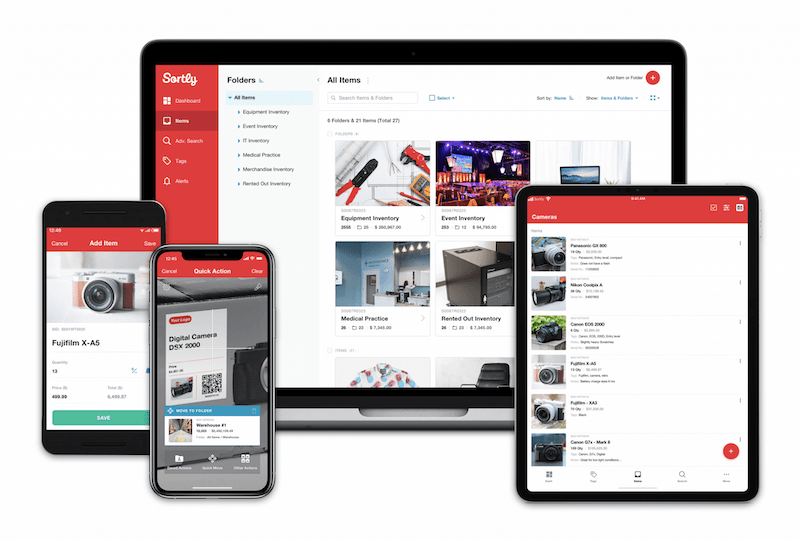In today’s landscape, businesses are constantly seeking strategies to optimize operations, mitigate risks, and enhance profitability. We surveyed approximately 70 Sortly customers across a range of industries to understand their most pressing concerns for the next 12 months and, crucially, how Sortly is helping them navigate these challenges. The results offer new insights into the power of effective inventory management in driving success, even amidst broader economic uncertainties.
Our survey revealed that Sortly customers, much like businesses across various sectors, are keenly aware of the macroeconomic pressures at play. When asked about their biggest concerns for their business in the next 12 months, “scaling operations and/or growth effectively” was a top concern, cited by 44.8% of respondents. Closely following were “supply chain disruptions” (41.8%) and “economic downturn and/or recession” (34.3%). Maintaining profitability also weighed heavily on their minds, with 32.8% indicating it as a significant concern. These figures paint a clear picture: businesses are looking for stability and efficiency in an unpredictable environment.

However, the survey also provided a strong testament to Sortly’s role in empowering businesses to overcome these hurdles. Despite these overarching concerns, a significant portion of our customers are experiencing tangible benefits directly attributable to their use of Sortly. This demonstrates that while external factors may be challenging, internal optimization, particularly in inventory management, can provide a crucial competitive edge.
Addressing Inventory Concerns Head-On
Inventory-related issues are often at the heart of many business challenges, and our survey confirms this. “Stockouts and project delays” were the leading inventory concern for 44.8% of respondents, while “overstocking and tied-up capital” was a concern for 43.3%. Fluctuating costs (26.9%) , and damage, spoilage, or obsolescence (20.9%) also featured prominently. These are not minor inconveniences; they represent direct threats to a business’s efficiency and bottom line.

The data strongly suggests that Sortly directly addresses these inventory pain points, and helps customers turn potential liabilities into assets. A remarkable 55.2% of respondents stated that Sortly has saved them money by improving inventory accuracy. This is a critical point, as accurate inventory data is the foundation for preventing both stockouts and overstocking. By providing real-time visibility into what’s on hand, where it is, and its condition, Sortly empowers businesses to make informed decisions and ensure they have the right amount of stock at the right time.

Furthermore, 35.8% of our customers reported that Sortly has reduced instances of lost or misplaced tools and materials. This directly tackles the “theft and loss” concern (13.4% of overall inventory concerns), but also contributes to greater efficiency and prevents costly re-purchases. When every item is accounted for, businesses avoid unnecessary expenditures and project delays caused by searching for or replacing essential equipment.
The Tangible Impact: Time and Money Savings
The most compelling data from our survey revolves around the direct time and money savings experienced by Sortly users. When asked how much time Sortly saves their team each week compared to their prior inventory solution, 32.8% of respondents estimated up to 5 hours per week. An additional 16.4% reported saving 5-10 hours per week , and a significant 9% indicated savings of 10 or more hours per week. While 41.8% were unsure of the exact time savings, the combined impact of those who could quantify it is substantial. Even saving “up to 5 hours per week” for a team can translate into significant productivity gains and reduced labor costs over time.

These time savings directly translate into financial benefits. Our survey found that 31.3% of customers reported Sortly has saved them money due to time savings. This underscores the inherent value of an efficient inventory system. When employees spend less time manually tracking inventory, searching for items, or correcting errors, they are freed up to focus on more strategic, revenue-generating activities.
Beyond time, Sortly’s financial impact is clear in other areas. 25.4% of respondents indicated that Sortly has saved them money by improving their purchasing process. This is likely due to better visibility into current stock levels, better demand forecasting, more precise purchasing decisions, and perhaps even use of key Sortly features like purchase orders. Additionally, 17.9% found that Sortly saved them money by better tracking material usage on projects, highlighting its utility in cost control for project-based businesses.
Investing in the Future: Technology as a Cost Reduction Strategy
The survey also explored actions businesses plan to take to reduce costs in the next 12 months. Encouragingly, “investing in technology to automate tasks” was a top strategy, chosen by 35.8% of respondents. This aligns perfectly with Sortly’s core offering and reinforces the idea that businesses are increasingly recognizing the long-term value of digital transformation in achieving cost efficiencies.

Other cost-reduction strategies identified include “stocking less inventory to save money” (34.3%) , “reducing overhead in some way” (31.3%) , and “switching vendors for more favorable prices” (31.3%). Sortly indirectly supports many of these initiatives. By providing accurate inventory data, businesses can confidently stock less without fear of stockouts, thus reducing tied-up capital and storage costs. Improved data can also empower more effective negotiations with vendors, as businesses have a clearer understanding of their true needs.
Looking Ahead: A Positive Outlook with Sortly
While global economic conditions may present ongoing challenges, our survey data paints an optimistic picture for Sortly users. They are not merely reacting to external pressures; they are proactively adopting solutions that provide tangible benefits. The fact that 9% of respondents reported Sortly saving them “10 or more hours per week” and over half (55.2%) confirming improved inventory accuracy leading to cost savings speaks volumes about the impact of a robust inventory management system.
Sortly customers are leveraging technology to address their biggest inventory concerns, gain control over their operations, and ultimately save both time and money. In an era where every dollar and every hour counts, the ability to manage inventory with precision and efficiency is not just a convenience—it’s a fundamental pillar of business resilience and growth. The results of this survey underscore that Sortly is more than an inventory solution to our customers; it’s a strategic partner in navigating the complexities of modern business.
About Sortly

Sortly is an inventory management solution that helps you track, manage, and organize your inventory from any device, in any location. We’re an easy-to-use inventory software that’s perfect for large or small companies. Sortly builds inventory tracking seamlessly into your workday so you can save time and money, satisfy your customers, and help your projects succeed.
With Sortly, you can track inventory, supplies, parts, tools, assets, and anything else that matters to your business. Sortly also comes equipped with smart features like barcoding & QR coding, low stock alerts, customizable folders, data-rich reporting, and much more. Best of all, you can update inventory right from your smartphone, whether you’re on the job, in the warehouse, or on the go.
Whether you’re just getting started with inventory management or you’re an expert looking for a more efficient solution, we can transform how your company manages inventory—so you can focus on your next build. That’s why over 15,000 businesses globally trust us as their inventory management solution.
Start your two-week free trial of Sortly today.




